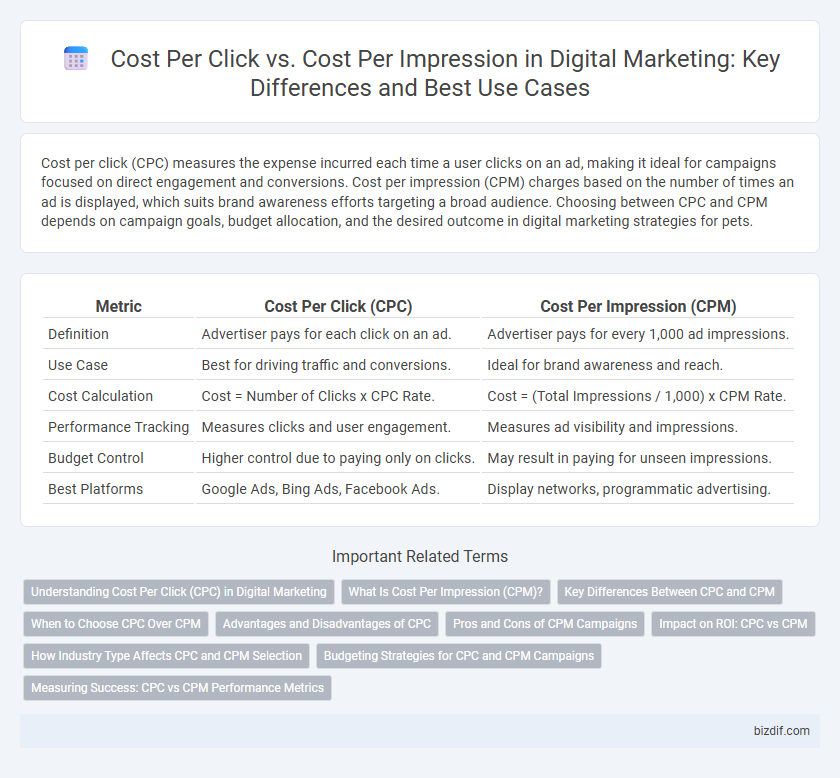Cost per click (CPC) measures the expense incurred each time a user clicks on an ad, making it ideal for campaigns focused on direct engagement and conversions. Cost per impression (CPM) charges based on the number of times an ad is displayed, which suits brand awareness efforts targeting a broad audience. Choosing between CPC and CPM depends on campaign goals, budget allocation, and the desired outcome in digital marketing strategies for pets.
Table of Comparison
| Metric | Cost Per Click (CPC) | Cost Per Impression (CPM) |
|---|---|---|
| Definition | Advertiser pays for each click on an ad. | Advertiser pays for every 1,000 ad impressions. |
| Use Case | Best for driving traffic and conversions. | Ideal for brand awareness and reach. |
| Cost Calculation | Cost = Number of Clicks x CPC Rate. | Cost = (Total Impressions / 1,000) x CPM Rate. |
| Performance Tracking | Measures clicks and user engagement. | Measures ad visibility and impressions. |
| Budget Control | Higher control due to paying only on clicks. | May result in paying for unseen impressions. |
| Best Platforms | Google Ads, Bing Ads, Facebook Ads. | Display networks, programmatic advertising. |
Understanding Cost Per Click (CPC) in Digital Marketing
Cost Per Click (CPC) in digital marketing measures the actual cost an advertiser pays each time a user clicks on their ad, making it a performance-based pricing model. CPC is essential for campaigns focused on driving traffic and conversions, as it directly ties ad spend to user engagement. Understanding CPC helps marketers optimize their bids and keywords for maximum return on investment while balancing budget and campaign goals.
What Is Cost Per Impression (CPM)?
Cost Per Impression (CPM) measures the cost an advertiser pays for one thousand ad impressions, focusing on brand visibility rather than direct clicks. CPM is ideal for campaigns aiming to increase awareness across large audiences, as it charges based on ad views instead of user actions. Understanding CPM enables marketers to optimize budget allocation for display and video ads where exposure is the primary goal.
Key Differences Between CPC and CPM
Cost per click (CPC) charges advertisers based on the number of clicks on their ads, making it ideal for performance-driven campaigns focused on direct user engagement. Cost per impression (CPM) bills advertisers per thousand ad impressions, emphasizing brand visibility and broad audience reach rather than immediate actions. Key differences include CPC's alignment with conversion goals and measurable ROI, while CPM prioritizes impression volume and awareness metrics.
When to Choose CPC Over CPM
Choosing Cost Per Click (CPC) over Cost Per Impression (CPM) is ideal for campaigns aimed at driving direct user actions like website visits, sign-ups, or purchases. CPC ensures you only pay when a user interacts with your ad, optimizing budget efficiency for performance-focused marketing goals. This model is especially effective for targeted campaigns where measurable engagement and conversion rates are critical metrics.
Advantages and Disadvantages of CPC
Cost per click (CPC) advertising ensures advertisers pay only when users engage directly with ads, maximizing budget efficiency and driving targeted traffic. Its advantage lies in clear performance measurement and higher ROI potential, but disadvantages include higher costs during competitive bidding and risk of click fraud. Unlike cost per impression (CPM), CPC focuses on user intent, making it ideal for conversion-driven campaigns but less effective for brand awareness.
Pros and Cons of CPM Campaigns
CPM (Cost Per Impression) campaigns offer high brand visibility by charging advertisers based on every thousand ad impressions, making them ideal for awareness-driven marketing. However, CPM does not guarantee user engagement or clicks, potentially leading to lower conversion rates compared to CPC (Cost Per Click) campaigns. While CPM campaigns are cost-effective for reaching large audiences, their lack of performance-based payment can result in inefficient spend if impressions do not translate to user action.
Impact on ROI: CPC vs CPM
Cost per click (CPC) directly ties advertising costs to user actions, making it highly effective for driving conversions and maximizing ROI in campaign strategies focused on engagement. Cost per impression (CPM) prioritizes brand visibility by charging based on ad views, which can boost awareness but may result in variable ROI due to less direct correlation with user actions. Marketers should align CPC campaigns with performance goals to ensure precise spending, while CPM suits campaigns aiming for widespread exposure and long-term brand equity.
How Industry Type Affects CPC and CPM Selection
Industry type significantly influences the choice between Cost per Click (CPC) and Cost per Impression (CPM) in digital marketing campaigns, as highly competitive sectors like finance and technology often favor CPC to maximize ROI through targeted clicks. Conversely, brand-focused industries such as fashion and consumer goods typically prefer CPM for broad reach and increased brand awareness. Understanding the specific goals and audience behavior within an industry enables marketers to optimize budget allocation and campaign performance effectively.
Budgeting Strategies for CPC and CPM Campaigns
Cost per click (CPC) budgeting requires precise keyword targeting and bid adjustments to maximize return on ad spend by paying only for actual clicks, making it ideal for conversion-driven campaigns. Cost per impression (CPM) budgeting focuses on brand visibility and reach, allocating funds to secure high-traffic placements that boost audience awareness regardless of immediate clicks. Effective budgeting strategies balance CPC and CPM campaigns by analyzing performance metrics like click-through rates (CTR), conversion rates, and cost per acquisition (CPA) to optimize overall marketing ROI.
Measuring Success: CPC vs CPM Performance Metrics
Cost per click (CPC) measures success by tracking the number of clicks an ad receives, providing direct insight into user engagement and conversion potential. Cost per impression (CPM) evaluates advertising reach by counting ad views, helping brands gauge visibility and awareness across a target audience. Analyzing both CPC and CPM performance metrics allows marketers to optimize campaign strategies based on whether the goal is immediate action or broader brand exposure.
Cost per click vs Cost per impression Infographic

 bizdif.com
bizdif.com